Hazard Analysis of Traditional Post-Harvest Operation Methods and the Loss Reduction Effect Based on Five Time (5T) Management: The Case of Rice in Jilin Province, China
Abstract
1. Introduction
2. 5T Management
3. Hazard Analysis of Traditional Post-harvest Operation Methods and Positive Effects of 5T Management
3.1. T1 Harvest Period
3.1.1. Rice Dry Matter Loss in the T1 Period
3.1.2. Loss Due to Grain Shattering in the T1 Period
3.2. T2 Field Period
3.3. T3 Drying Period
3.4. T4 Warehousing Period
3.5. T5 Storage Period
4. Loss Reduction Effect of 5T Management on Rice Post-harvest
5. Discussion and Conclusions
- The dry matter weight of rice decreased with heading time, and the results of the analysis indicated that delayed harvesting time is partially responsible for the loss, as it causes latent reductions in dry matter. Although this part of the loss can easily be ignored, the results show that when rice was not harvested at the optimal time, the dry matter loss reached 3.47%, and the loss due to falling grains reached 3.02%. Therefore, when the 5T management method is applied and rice is harvested at the optimal time, the loss rate can be reduced by 4.33%, which is equivalent to 9.17 million tonnes of rice.
- With the increase in the amount of time plants spend stacked in the field, the probability of mildew affecting the plants and the grain cracking rate increase. When rice plants are kept in stacks for long periods, the loss rate will be 3.5%. According to the 5T management method, rice plants should be dried immediately after harvest, and the amount of time they remain stacked in the field should not exceed 48 h. Following these guidelines can reduce the loss rate during field stacking by 2.5%, which is equivalent to a reduction of 5.3 million tonnes.
- Traditional natural drying methods result in a loss rate of 3%. However, common low-cost mechanical drying methods cause uneven levels of drying in rice, and cause the cracking rate to increase, resulting in a 2% loss rate due to over-drying. According to the 5T management method, a low-temperature or variable-temperature drying process should be adopted for rice, and the average rate of moisture reduction should not be higher than 0.8%/h to ensure the quality of the grains. Mechanical drying can reduce the loss rate of natural drying by 1.6%, which is equivalent to approximately 3.39 million tonnes of rice. Proper mechanical drying can reduce the loss rate of over-drying by 0.6% (approximately 1.27 million tonnes of rice).
- Rice should be stored or processed immediately after drying. If rice is left too long after drying without being stored or processed, it will absorb ambient moisture, resulting in fissures or cracks and grains that are easily broken during processing. According to the 5T management method, the warehousing time should be strictly controlled, and rice should be stored or processed within 24 h after drying; following these guidelines can reduce the rate of grain damage, improve the percentage of high-quality rice obtained from a harvest, and improve rice yield and quality.
- If rice is not processed after drying, it should be stored in an appropriate amount of time, and the storage process should be reasonably controlled. Traditional rice storage methods result in a 9% loss rate. According to the 5T management method, the moisture content in rice should be controlled before storage, and low-temperature storage technology should be adopted to slow ageing; these practices could reduce the rate of loss during storage (7%), which is equivalent to a rice yield of 14.83 million tonnes.
Author Contributions
Funding
Data Availability Statement
Acknowledgments
Conflicts of Interest
References
- Li, X.P.; Shen, J.; Li, Y.L.; Feng, Z.Q.; Zhai, X.N.; Lou, Z. The Enlightenments and Influences of Foreign Countries’ Grain Collection & Storage Technique to China. Modem Food 2018, 6, 148–153. [Google Scholar]
- Tan, B.G.; Tan, W.; Zhou, X.Q. The enlightenment of Japanese rice industry development to our country. Sci. Technol. Cereals Oils Foods 2014, 2, 36–37. [Google Scholar]
- Schmidley, A.; Choudhury, M.; Salahuddin, A.; Maier, D.E. Reducing losses and improving actor incomes in Bangladesh’s postharvest rice value chains: Initial assessment results and recommendations for the future. In Proceedings of the International Working Conference on Stored Product Protection, Chiang Mai, Thailand, 24–28 November 2014. [Google Scholar]
- Harris, K.L.; Lindblad, C.J. Postharvest Grain Loss Assessment Methods: A Manual of Methods for the Evaluation of Postharvest Losses; American Association of Cereal Chemists: Eagan, MN, USA, 1978. [Google Scholar]
- Generalov, I.; Suslov, S.; Bazhenov, R.; Sibiryaev, A.; Firsova, E. Management system of grain production cluster of the region. IOP Conf. Ser. Earth Environ. Sci. 2020, 241, 032018. [Google Scholar] [CrossRef]
- Tefera, T.; Kanampiu, F.; De Groote, H.; Hellin, J.; Mugo, S.; Kimenju, S.; Beyene, Y.; Boddupalli, P.M.; Shiferaw, B.; Banziger, M. The metal silo: An effective grain storage technology for reducing post-harvest insect and pathogen losses in maize while improving smallholder farmers’ food security in developing countries. Crop. Prot. 2011, 30, 240–245. [Google Scholar] [CrossRef]
- Dowell, F.E.; Dowell, C.N. Reducing grain storage losses in developing countries. Qual. Assur. Saf. Crops Foods 2017, 9, 93–100. [Google Scholar] [CrossRef]
- Ashish, M.; Paschal, M.; Ajay, S. An Overview of the Post-Harvest Grain Storage Practices of Smallholder Farmers in Developing Countries. Agriculture 2018, 8, 57. [Google Scholar]
- Kumar, D.; Kalita, P. Reducing Postharvest Losses during Storage of Grain Crops to Strengthen Food Security in Developing Countries. Foods 2017, 6, 8. [Google Scholar] [CrossRef]
- Makinya, K.J.; Wagacha, J.M.; Odhiambo, J.A.; Likhayo, P.; Mutungi, C.M. The importance of store hygiene for reducing post-harvest losses in smallholder farmers’ stores: Evidence from a maize-based farming system in Kenya. J. Stored Prod. Res. 2021, 90, 101757. [Google Scholar] [CrossRef]
- Hodges, R.J.; Buzby, J.C.; Bennett, B. Postharvest losses and waste in developed and less developed countries: Opportunities to improve resource use. J. Agric. Sci. 2011, 149, 37–45. [Google Scholar] [CrossRef]
- Bendinelli, W.E.; Su, C.T.; Péra, T.G.; Caixeta Filho, J.V. What are the main factors that determine post-harvest losses of grains? Sustain. Prod. Consum. 2020, 21, 228–238. [Google Scholar] [CrossRef]
- Shimin, T. We will strengthen grain conservation and reduce food losses to ensure food security. Grain News 2020, B03, 1–2. [Google Scholar]
- Sheahan, M.; Barrett, C.B. Review: Food loss and waste in Sub-Saharan Africa. Food Policy 2017, 70, 1–12. [Google Scholar] [CrossRef] [PubMed]
- Abass, A.B.; Ndunguru, G.; Mamiro, P. Post-harvest food losses in a maize-based farming system of semi-arid savannah area of Tanzania. J. Stored Prod. Res. 2014, 57, 49–57. [Google Scholar] [CrossRef]
- Sarkar, D.; Datta, V.; Chattopadhyay, K.S. Assessment of Pre and Post Harvest Losses in Rice and Wheat in West Bengal; Agro-Economic Research Centre, Visva-Bharati, Santiniketan: Santiniketan, India, 2013. [Google Scholar]
- Calverley, D. A Study of Loss Assessment in Eleven Projects in Asia Concerned With Paddy; Food and Agriculture Organization of the United Nations: Rome, Italy, 1996. [Google Scholar]
- Grover, D.; Singh, J. Post-harvest losses in wheat crop in Punjab: Past and present. Agric. Econ. Res. Rev. 2013, 26, 293–297. [Google Scholar]
- Costa, S.J. Reducing Food Losses in Sub-Saharan Africa (Improving Post-Harvest Management and Storage Technologies of Smallholder Farmers); UN World Food Programme: Kampala, Uganda, 2014. [Google Scholar]
- Deutsche Gesellschaft für Internationale Zusammenarbeit (GIZ) GmbH. Post-Harvest Losses of Rice in Nigeria and Their Ecological Footprint; Deutsche Gesellschaft für Internationale Zusammenarbeit (GIZ) GmbH: Bonn/Eschborn, Germany, 2014. [Google Scholar]
- Kannan, E.; Kumar, P.; Vishnu, K.; Abraham, H. Assessment of Pre and Post Harvest Losses of Rice and Red Gram in Karnataka; Agricultural Development and Rural Transformation Centre, Institute for Social and Economic Change: Banglore, India, 2015. [Google Scholar]
- Liu, H.Q.; Zhou, T. The Effect on the Taste Quality from the Timely Harvesting and Drying Process of Rice. North Rice 2017, 47, 1–6. [Google Scholar]
- Alavi, H.R.; Htenas, A.; Kopicki, R. Trusting Trade and the Private Sector for Food Security in Southeast Asia; World Bank Publications: Washington, DC, USA, 2011. [Google Scholar]
- Gao, Y.; Zhou, J.P.; Cao, Y.M. Investigation on shattering of rice. Mod. Agric. Sci. Technol. 2014, 4, 79–83. [Google Scholar]
- Shi, M.; Paudel, K.P.; Chen, F.B. Mechanization and efficiency in rice production in China. J. Integr. Agric. 2021, 20, 1996–2008. [Google Scholar] [CrossRef]
- Atungulu, G.G.; Kolb, R.E.; Karcher, J. Postharvest technology: Rice drying. Rice Chem. Technol. 2019, 473–515. [Google Scholar]
- Atungulu, G.G.; Kolb, R.E.; Karcher, J. Postharvest technology: Rice storage and cooling conservation. Rice Chem. Technol. 2019, 517–555. [Google Scholar]
- Hien, P.H. Mechanization and postharvest technologies in the rice sector of Vietnam. Acta Hortic. 2018, 1213, 31–40. [Google Scholar]
- Gummert, M. Improved postharvest technologies and management for reducing postharvest losses in rice. Acta Hortic. 2013, 1011, 63–70. [Google Scholar] [CrossRef]
- Yin, H.Z.; Shen, Y.K.; Chen, Y.; Yu, Z.X.; Li, P.T. Accumulation and translocation of dry matter after flowering in rice. J. Integr. Plant Biol. 1956, 2, 177–194. [Google Scholar]
- Song, Y.J.; Wu, C.; Li, Z.Y.; Tang, S.; Li, G.H.; Wang, S.H.; Ding, Y.F. Differential Responses of Grain Yields to High Temperature in Different Stages of Reproductive Growth in Rice. Chin. J. Rice Sci. 2021, 2, 177–186. [Google Scholar]
- Xu, J.P.; Wang, J.; Xu, X.J.; Ju, S.C. Image recognition for different developmental stages of rice by RAdam deep convolutional neural networks. Trans. Chin. Soc. Agric. Eng. (Trans. CSAE) 2021, 37, 143–150. [Google Scholar]
- Zhang, H.C.; Xing, Z.P.; Weng, W.N. Growth Characteristics and Key Techniques for Stable Yield of Growth Constrained Direct Seeding Rice. Sci. Agric. Sin. 2021, 54, 1322–1337. [Google Scholar]
- Wu, W.F.; Zhang, N.; Li, S.Y.; Wang, Y.J.; Xu, W.; Meng, X.M.; Zhu, H.; Qi, J.T.; Zhou, X.G.; Liu, H.Q. Construction and application exploration of 5T smart farm management systems. Trans. Chin. Soc. Agric. Eng. (Trans. CSAE) 2021, 37, 340–349. [Google Scholar]
- Wimmer, J.E. Levels of Care for Perinatal Health. N. C. Med. J. 2020, 81, 32–35. [Google Scholar] [CrossRef] [PubMed]
- Alzghoul, M.M.; Møller, H.; Wakewich, P.; Dowsley, M. Perinatal care experiences of Muslim women in Northwestern Ontario, Canada: A qualitative study. Women Birth. 2021, 31, 162–169. [Google Scholar] [CrossRef]
- DB22/T 3113-2020. 5T Post-Harvest Management Technique Code for High Quality Paddy; Jilin Market Supervision and Management Department: Jilin, China, 2020.
- Zhang, H.M.; Zheng, X.Z.; Song, X.Y. Study of rice quality compared immediately drying with deferred drying in different harvest time. J. Northeast Agric. Univ. 2012, 8, 30–33. [Google Scholar]
- Yasuhiro, S. Present situation and development trend of rice post-harvest drying technology system in Japan. In Proceedings of the 2008 Sino-Japanese Rice Drying New Technology Seminar, Chengdu, China, 20–22 November 2008. [Google Scholar]
- Xu, R.Q.; Liu, J.W.; Zhang, C.M.; Kiyokazu, G.; Yoshihiro, M. Researches on the influence of harvest in appropriate time on paddy loss. Grian Storage 2003, 3, 47–50. [Google Scholar]
- Wang, G.M.; Yi, Z.Y.; Chen, C.; Chao, G.Q. Effect of harvesting date on loss component characteristics of rice mechanical harvested in rice and wheat rotation area. Trans. Chin. Soc. Agric. Eng. (Trans. CSAE) 2016, 32, 36–42. [Google Scholar]
- Li, S.Y.; He, D.; Zhang, J.H.; Bai, L. Causes and mitigation strategies of rice harvest and postnatal loss from the perspective of farmers: A survey from four major producing areas in Jilin Province. Henan Nongye 2020, 2, 8–10. [Google Scholar]
- Huang, D.; Yao, L.; Wu, L.P.; Zhu, X.D. Measuring Rice Loss during Harvest in China: Based on Experiment and Survey in Five Provinces. J. Nat. Resour. 2018, 33, 1427–1438. [Google Scholar]
- Khir, R.; Atungulu, G.; Chao, D.; Pan, Z. Influences of harvester and weather conditions on field loss and milling quality of rough rice. Int. J. Agric. Biol. Eng. 2017, 10, 216–223. [Google Scholar] [CrossRef][Green Version]
- Soraya, S.; Shantae, A.W.; Griffiths, G.A. Impacts of storage temperature and rice moisture content on color characteristics of rice from fields with different disease management practices. J. Stored Prod. Res. 2018, 78, 89–97. [Google Scholar]
- Zhang, L.D.; Li, X.J.; Ren, G.Y.; Xu, D.; Zhang, Z.J.; Zhang, C.F.; Chen, X. Quality Change of High Moisture Content Rice Under Different Storage Conditions. J. Chin. Cereals Oils Assoc. 2018, 33, 77–84. [Google Scholar]
- Shao, B. Mycotoxin contamination and early prediction of rice. Tea In Fujian 2020, 4, 3. [Google Scholar]
- Lu, Y. Study on Emergency Measures for Storing High Moisture Paddy and Design of Grain Storage Device. Master’s Thesis, Zhejiang A&F University, Zhejiang, China, 2018. [Google Scholar]
- Shen, W.H. Research on Portable Biohazard Detector for Post-Harvested Grain. Master’s Thesis, Jilin University, Changchun, China, 2020. [Google Scholar]
- Wang, Z. Characteristics of the CO2 Produced by Mold Activity and the Diffusion Law in the Rice during Storage. Master’s Thesis, Henan University of Technology, Zhengzhou, China, 2012. [Google Scholar]
- Zhang, Q.; Liu, C.H.; Sun, J.K.; Cui, Y.J.; Li, Q.; Jia, F.G.; Zheng, X.Z. Rapid Non-destructive Detection for Molds Colony of Paddy Rice Based on Near Infrared Spectroscopy. J. Northeast Agric. Univ.(Engl. Ed.) 2014, 21, 54–60. [Google Scholar]
- Liu, X.D. The function of grain drying equipment in grain safe storage. Hunan Agric. Mach. 2014, 41, 136–140. [Google Scholar]
- Li, K.L.; Tian, F.; Wang, D. Wang Daneng. Comparison of Aflatoxin B1(AFB1)Cumulative Risk of Paddy Rice and Brown Rice with Different Water Activity. J. Chin. Cereals Oils Assoc. 2018, 10, 98–103. [Google Scholar]
- Yu, Y.; Li, W.Y.; Wang, J. Effect of γ-Ray Irradiation Pre-treatment on Embryo Structure and Germination Characteristics of Rice Seeds. J. Chin. Cereal Oil Assoc. 2009, 21, 1–6. [Google Scholar]
- Zhang, J.J. Pay attention to post-harvest technology of paddy, and strive to reduce the loss to the lowest degree. China Rice 2000, 5, 7–9. [Google Scholar]
- Zhang, R.D.; Wang, R.L.; Qu, S.L.; Geng, X.Z. The law of heat and moisture transfer and critical parameters of condensation during storage of paddy with higher water conten. J. Henan Univ. Technol. (Nat. Sci. Ed.) 2020, 41, 94–99. [Google Scholar]
- Liu, H.; Zhou, J.X.; Fang, Y. Microorganism and Quality Changes During Paddy Storage. J. Chin. Cereals Oils Assoc. 2020, 35, 126–131. [Google Scholar]
- Wu, M.L.; Tang, C.Z. Research progress on mechanism and influencing factors of rice crackle. Cereals Oils Process. (Electron. Vers.) 2006, 2, 60–63. [Google Scholar]
- Li, D.; Mao, Z.H.; Wang, L.J.; Wang, Z.B. Mechanism and inhibition of waist burst in rice. Mach. Cereals Oil Food Process. 2000, 4, 17–18. [Google Scholar]
- Li, D.; Mao, Z.H. Microscopic structure of rough rice after sun drying. Trans. Chin. Soc. Agric. Eng. (Trans. CSAE) 2003, 19, 156–159. [Google Scholar]
- Meas, P.; Paterson, A.; Cleland, D.J.; Brinlund, J.E.; Mawson, J.; Hardacre, A.; Rcikman, J.F. Relating Rice Grain Quality to Conditions during Sun Drying. Int. J. Food Eng. 2013, 9, 385–391. [Google Scholar] [CrossRef]
- Lu, M.D. Develop mechanical drying of rice to reduce sun drying loss. Non-State Run. Sci. Technol. Enterp. 2017, 1, 262–265. [Google Scholar]
- Yuan, P.Q.; Yang, S.C.; Zhao, H.Y.; Zhang, H.Q.; Tian, L.; Zhang, H.; Wang, Y.; Cao, Y. Impact of Three Drying Methods on Rice Quality. J. Chin. Cereals Oils Assoc. 2020, 35, 109–116. [Google Scholar]
- Li, Y.N. Hunan early rice grain warehouse zoomlion dryer to help a lot. Agric. Mach. Qual. Superv. 2017, 7, 421. [Google Scholar]
- Alam, M.; Saha, C.; Alam, M. Mechanical drying of paddy using BAU-STR dryer for reducing drying losses in Bangladesh. Progress. Agric. 2019, 30, 42–50. [Google Scholar] [CrossRef][Green Version]
- Drying Grain on Asphalt Roads Is Prohibited. Available online: http://www.rmzxb.com.cn/c/2017-03-31/1452858.shtml (accessed on 31 March 2017).
- Luo, B.Y.; Huang, X.H.; Peng, R.X.; Liu, K.S. Discussion on Speeding Up Development of Rice Drying Mechanization. Times Agric. Mach. 2016, 43, 4–5. [Google Scholar]
- Yang, G.F.; Wan, Z.M. Study on crack formation tendency of dry rice. J. Nanjing Univ. Econ. 1995, 3, 17–20. [Google Scholar]
- Wu, S.X.; Liu, R.X.; Yang, W.F. Drying test of paddy grain with high moisture by low-temperature recirculation dryer. Food Mach. 2011, 6, 192–194. [Google Scholar]
- Tanaka, S.; Tanaka, F.; Okubo, T.; Maeda, Y.; Urasa, L.R. Low Temperature Drying Characteristics of Raw Rough Rice. J. Jpn. Soc. Agric. Mach. 2000, 62, 104–109. [Google Scholar]
- Li, W.Q. Reduce rice crackle and breakage and improve rice yield. Grain Process. 2014, 39, 33–36. [Google Scholar]
- Wu, Z.H.; Liu, B.; Wang, D.; Kang, N.; Zhao, L. Drying-Tempering Characteristics and Fissuring Law of Paddy Rice Kernel. Trans. Chin. Soc. Agric. Mach. 2018, 49, 368–374. [Google Scholar]
- Kim, H.; Han, J. Quality Characteristics of Rough Rice during Low Temperature Drying. Korean J. Food Preserv. 2009, 16, 650–655. [Google Scholar]
- Wang, J.H.; Liu, Q.J. Researches on key techniques for paddy seed drying. Trans. Chin. Soc. Agric. Eng. (Trans. CSAE) 2004, 20, 213–216. [Google Scholar]
- GB/T 21015-2007. Technical Specifications for Paddy Drying, General Administration of Quality Supervision; Inspection and Quarantine of the People’s Republic of China: Beijing, China, 2007.
- Qian, X.S.; Zhao, Y.R.; Zheng, M.S.; Zheng, M. Low-temperature aging and drying treatments of restorative rice to improve its microbial safety and texture. Korean J. Food Sci. Technol. 2019, 51, 29–34. [Google Scholar]
- Yang, G.F. Dynamic Analysis of Fractal Model in Rice Moisture—Adorption Crack. J. Chin. Cereals Oils Assoc. 2011, 9, 6–13. [Google Scholar]
- Wang, Z.; Chen, J.; Liang, L.Y. Mechanism on the formation and development of moisture-adsorption cracks of paddy. Grain Storage 2011, 1, 30–35. [Google Scholar]
- Darmajana, D.A.; Indriati, A.; Rahmawati, D. Study of isothermic absorption model of moisture content of fibrous instant corn rice. IOP Conf. Ser. Mater. Sci. Eng. 2021, 1011, 012022. [Google Scholar] [CrossRef]
- Zhang, J.N.; Wang, Q.S.; Tan, J. Influences of Moisture Contents and Environment Conditions on Rice Cracking Caused by Moisture Adsorption. Cereal Feed Ind. 1999, 12, 14–15. [Google Scholar]
- Kunze, O.R. Moisture adsorption influences on paddy. J. Food Process. Eng. 1977, 1, 167–181. [Google Scholar] [CrossRef]
- Li, Y. The Research of the Effection of Adsorption and Desorption and Class Transition of Rough Rice to Fissures. Master’s Thesis, Jilin University, Changchun, China, 2016. [Google Scholar]
- Cheng, Q.Q.; Liu, Y.M.; Zhang, J.N.; Wang, Q.S. The Study Advance of Paddy Cracking Caused by Moisture Adsorption. Cereal Feed Ind. 2000, 11, 8–9. [Google Scholar]
- Yang, H.P.; Li, D.K.; Qiao, L. The Change of Water Distribution in the Process of Adsorption/Desorption in Japonica by LF-NMR. J. Chin. Cereals Oils Assoc. 2016, 31, 6–11. [Google Scholar]
- Xi, M.; Zhou, J.X.; Ge, Z.W.; Cao, Y. Study on the changes of microbial biomass and quality of rice during stacking storage. Grain Sci. Technol. Econ. 2018, 43, 59–62. [Google Scholar]
- Wang, Q.Y.; Wu, W.F.; Lan, T.Y. Models for predicting the fatty acid contents of rice during storage in the northeast China. Trans. Chin. Soc. Agric. Eng. (Trans. CSAE) 2020, 36, 269–275. [Google Scholar]
- Zhou, X.Q.; Zhu, F.Q.; Zhang, Y.R. Analysis of the Storage Property, Physiological, Biochemical Indicators Parameters and the Pasting Characteristics of Rice in Different Storage Time. J. Chin. Cereals Oils Assoc. 2020, 35, 108–114, 124. [Google Scholar]
- Xi, M.; Zhou, J.; Ge, Z.; Qi, X. Succession Rule of Microbial Flora of Paddy Heap During Storage. J. Chin. Cereal Oil Assoc. 2019, 34, 90–95. [Google Scholar]
- Shi, J.Y.; Zhang, T.; Geng, S.F. Effect of accumulated temperature on flavour and microbial diversity of japonica paddy during storage. J. Stored Prod. Res. 2021, 92, 101779. [Google Scholar] [CrossRef]
- Bertuzzi, T.; Marco, R.; Rastelli, S.; Giorni, P. Mycotoxins and Related Fungi in Italian Paddy Rice During the Growing Season and Storage. Toxins 2019, 11, 151. [Google Scholar] [CrossRef] [PubMed]
- Chen, J.; Wang, Y.; Guao, L.; Wang, Z.W. Research on controlling annual accumulated temperature of grain for sage storage. Grain Storage 2007, 36, 19–22, 27. [Google Scholar]
- Yang, H.P.; Liu, L.; Dong, W. Study on the Fatty Acid Value and Odor of Rice in Different Storage Conditions. J. Chin. Cereals Oils Assoc. 2013, 28, 85–89. [Google Scholar]
- Duan, Y.S.; Ma, J.Y.; Li, X.J.; D, J.; Feng, J.D. Changes in Grain Bulk Properties of Japonica Paddy in a Warehouse and Processing Quality during Lower Temperature Storage. Sci. Technol. Food Ind. 2021, 42, 289–298. [Google Scholar]
- Yu, J.Q.; Zhou, Z.C. Keeping paddy fresh with low temperature storage technology. Grain Storage 2006, 35, 17–20. [Google Scholar]
- Li, Z.Z.; Qu, C.L.; Wang, H.L.; Wang, R.L.; Wan, L.H. Comparative Study on the Quality Changes of the High Quality Paddy During Quasi-Low Temperature Storage and Conventional Temperature Storage. J. Chin. Cereals Oils Assoc. 2020, 35, 101–110. [Google Scholar]
- Chen, Y.C.; Liu, J.; Li, H.Q. Effect of Different Temperature Preservation Storage on Rice Quality. Grain Process. 2019, 44, 40–42. [Google Scholar]
- Shu, Z.X.; Jia, W.Q.; Zhang, W. Selected quality attributes of paddy rice as affected by storage temperature history. Int. J. Food Prop. 2021, 24, 316–324. [Google Scholar] [CrossRef]
- Carvalho, M.O.; Fradinho, P.C.; Martins, M.J. Paddy rice stored under hermetic conditions: The effect of relative humidity, temperature and storage time in suppressing Sitophilus zeamais and impact on rice quality. J. Stored Prod. Res. 2019, 80, 21–27. [Google Scholar] [CrossRef]
- Wu, Z.D.; Zhang, Q.; Wu, W.F. Current Application and Outlook Prospect of AI Technology in the Field of Post-harvested Cereal. J. Chin. Cereals Oils Assoc. 2019, 34, 133–139. [Google Scholar]
- Wang, H.; Qu, C.; Wang, R. Research on Quality Changes of High Quality Paddy in Conventional Storage. J. Chin. Cereal Oil Assoc. 2019, 34, 97–103. [Google Scholar]
- Wu, W.F.; Zhang, N.; Xu, W.; Li, S.Y.; Wang, Y.J.; Meng, X.M. Jilin Rice 5T Management Integrated Information System. Trans. Chin. Soc. Agric. Eng. (Trans. CSAE) 2021, 42, 51–56. [Google Scholar]
- National Bureau of Statistics. Statistical Bulletin of the People’s Republic of China on National Economic and Social Development; National Bureau of Statistics: Beijing, China, 2021. Available online: http://www.stats.gov.cn/ztjc/zthd/lhfw/2021/lh_hgjj/202103/t202103011814216.html (accessed on 28 February 2021).
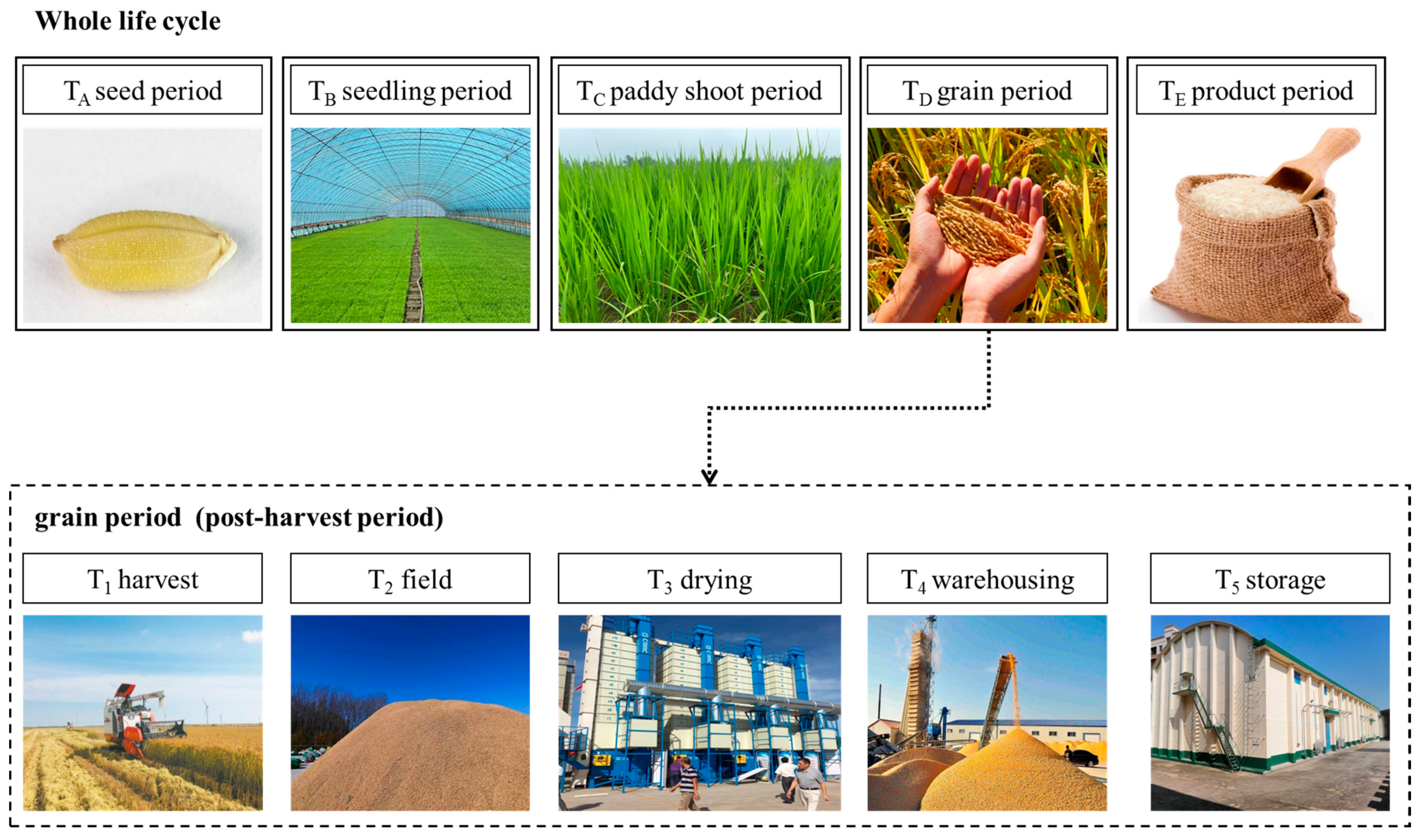
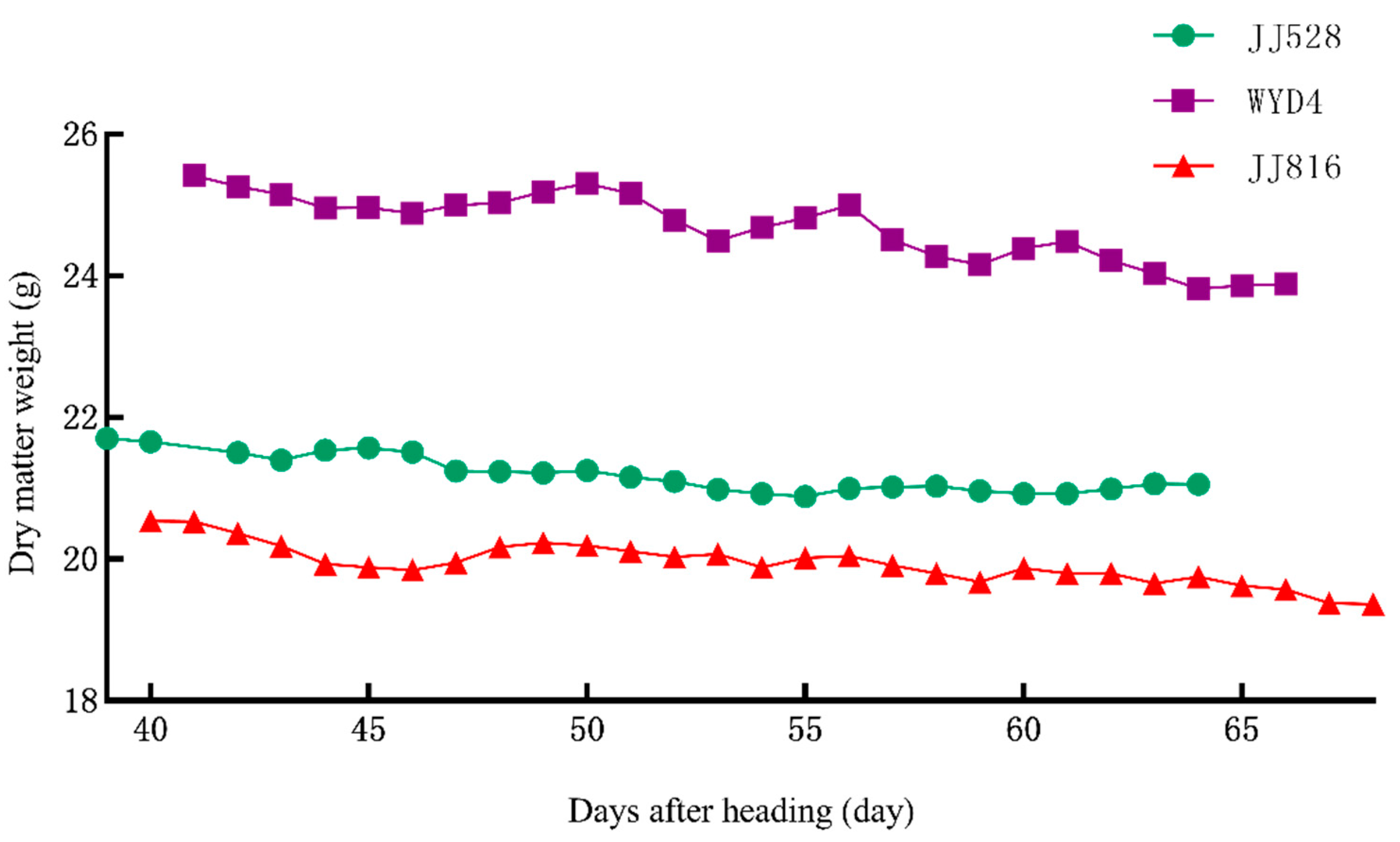

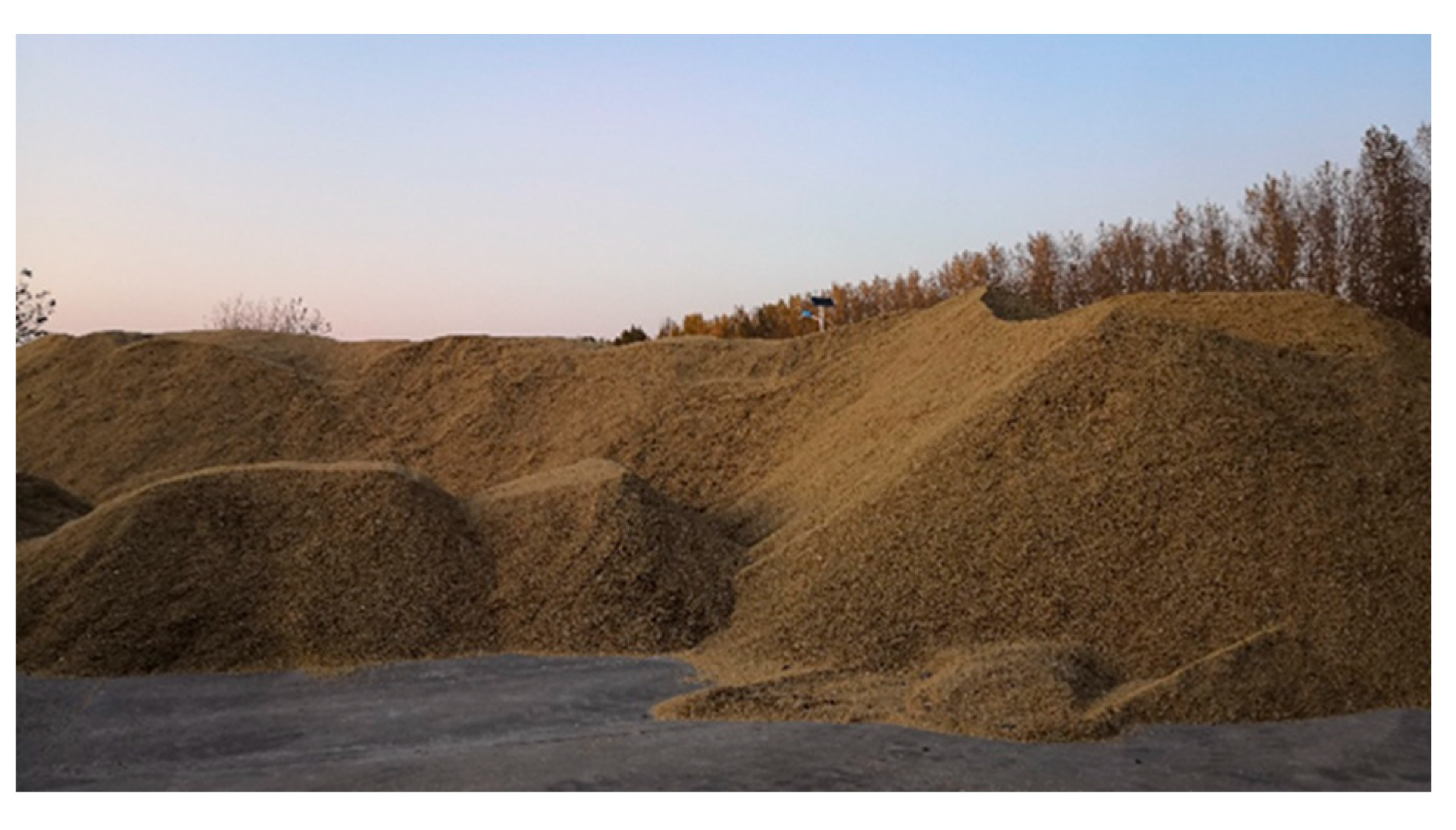
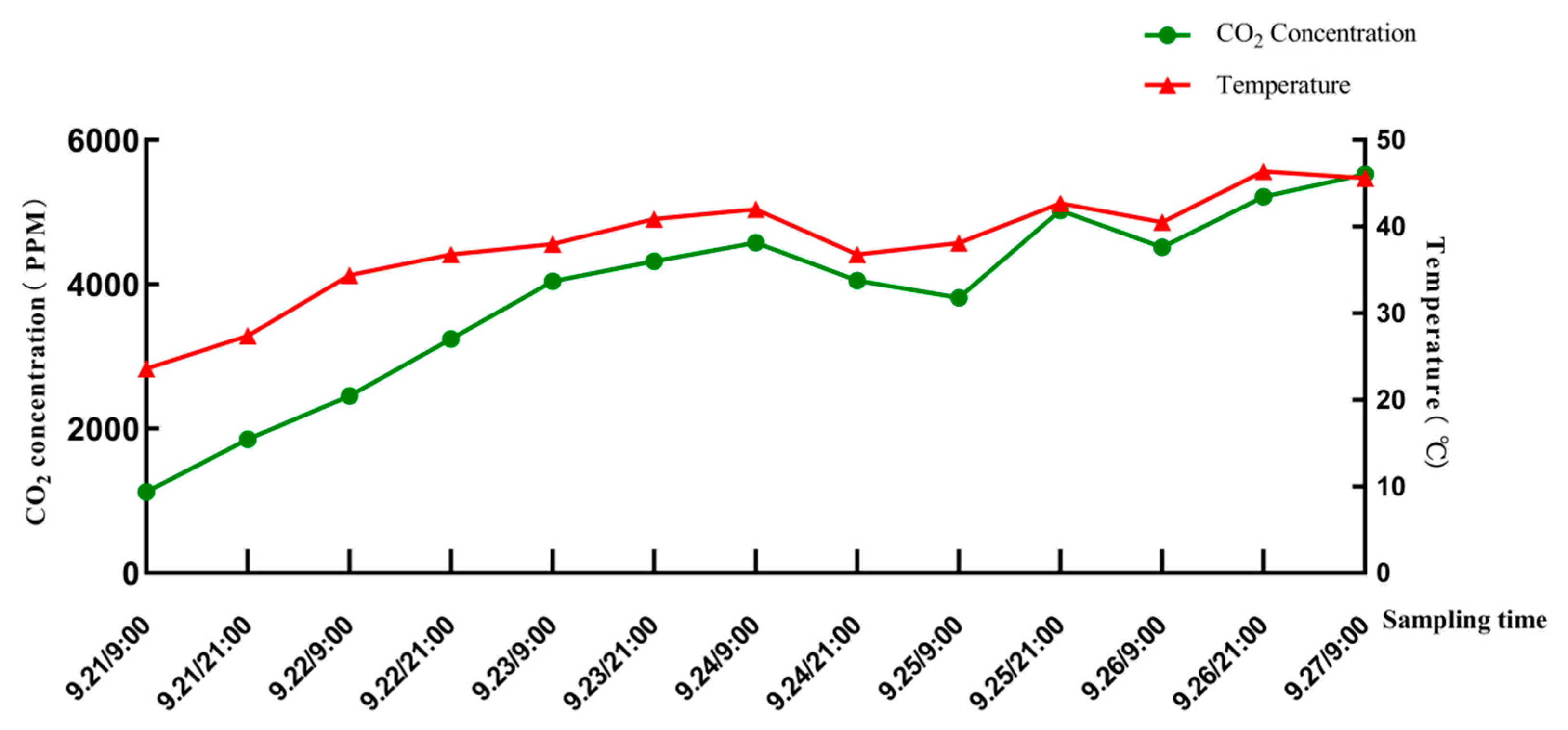
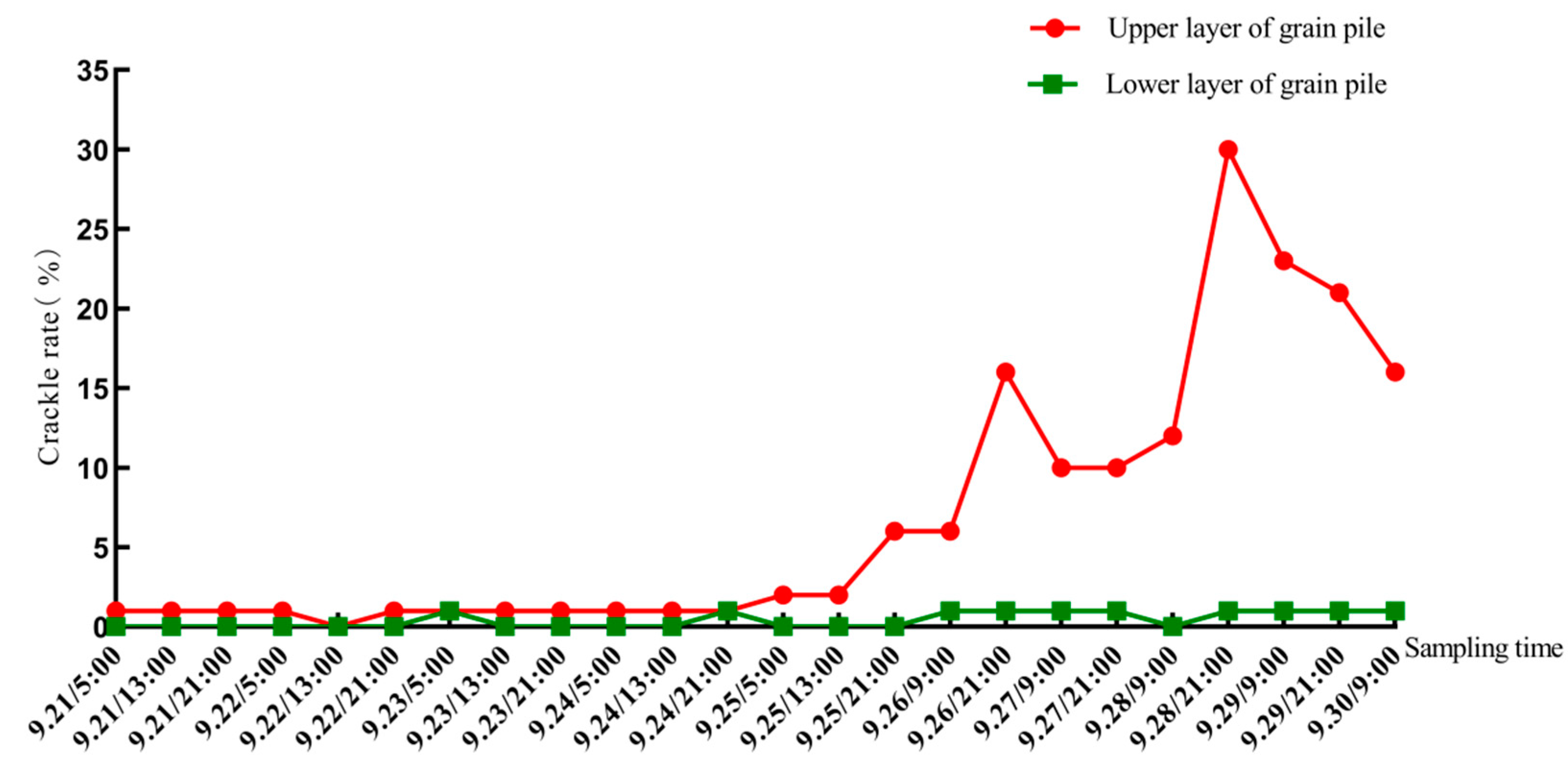


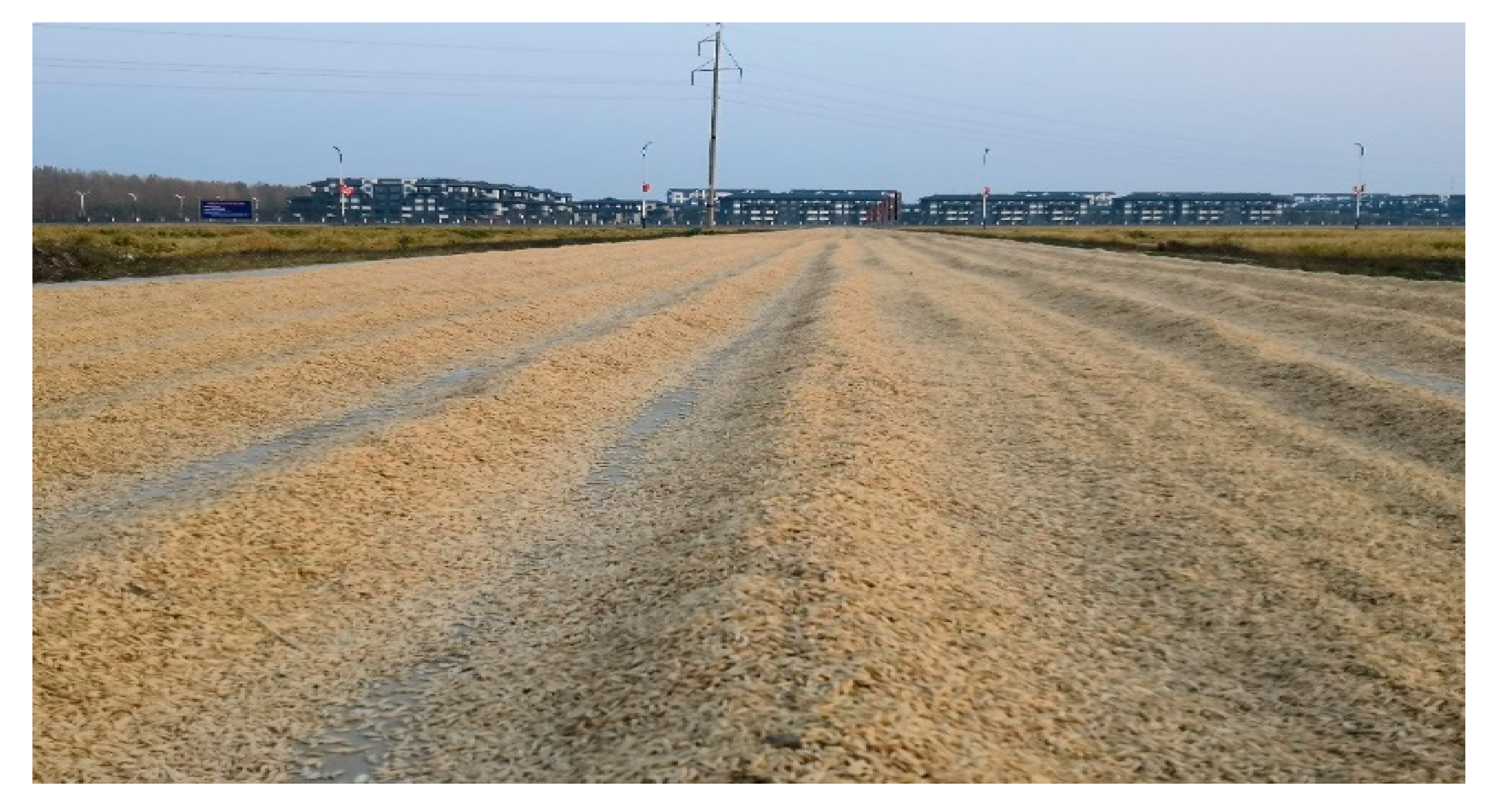
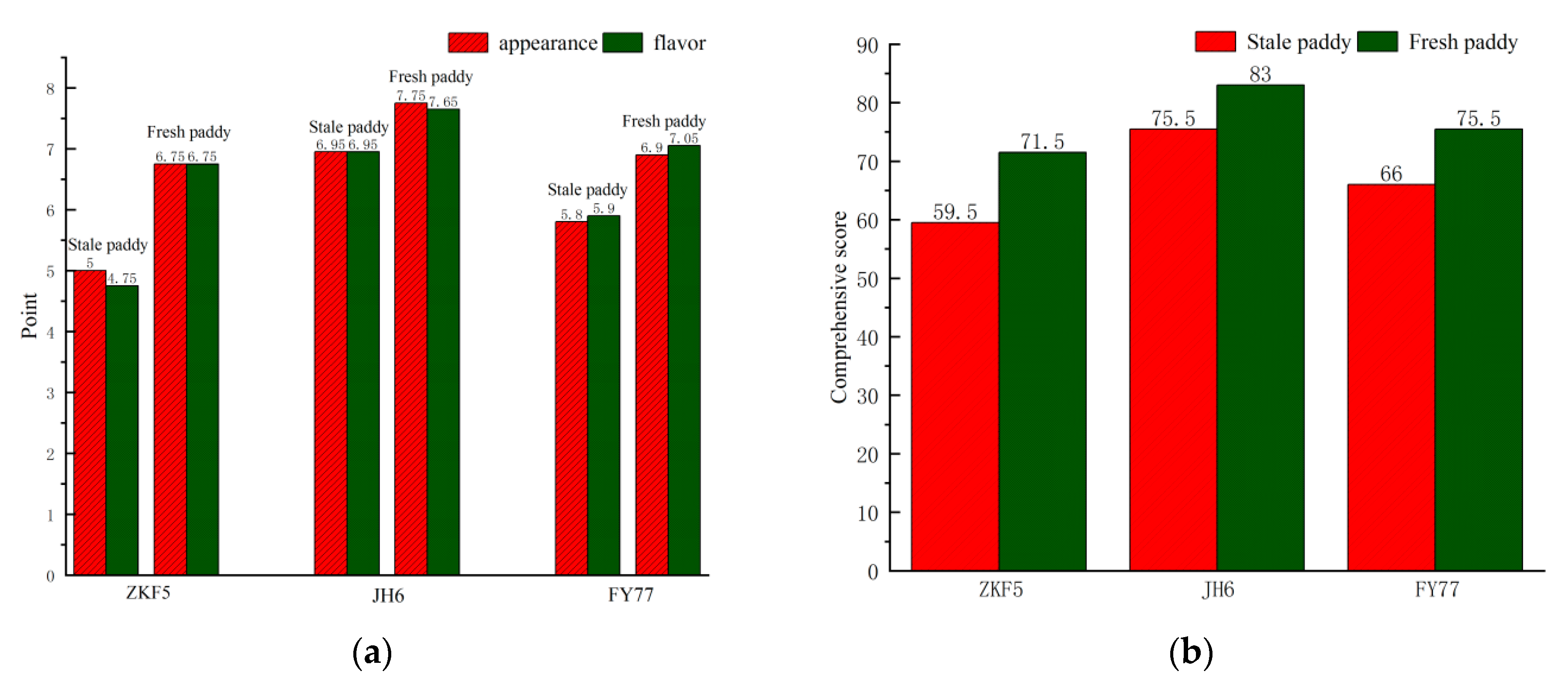
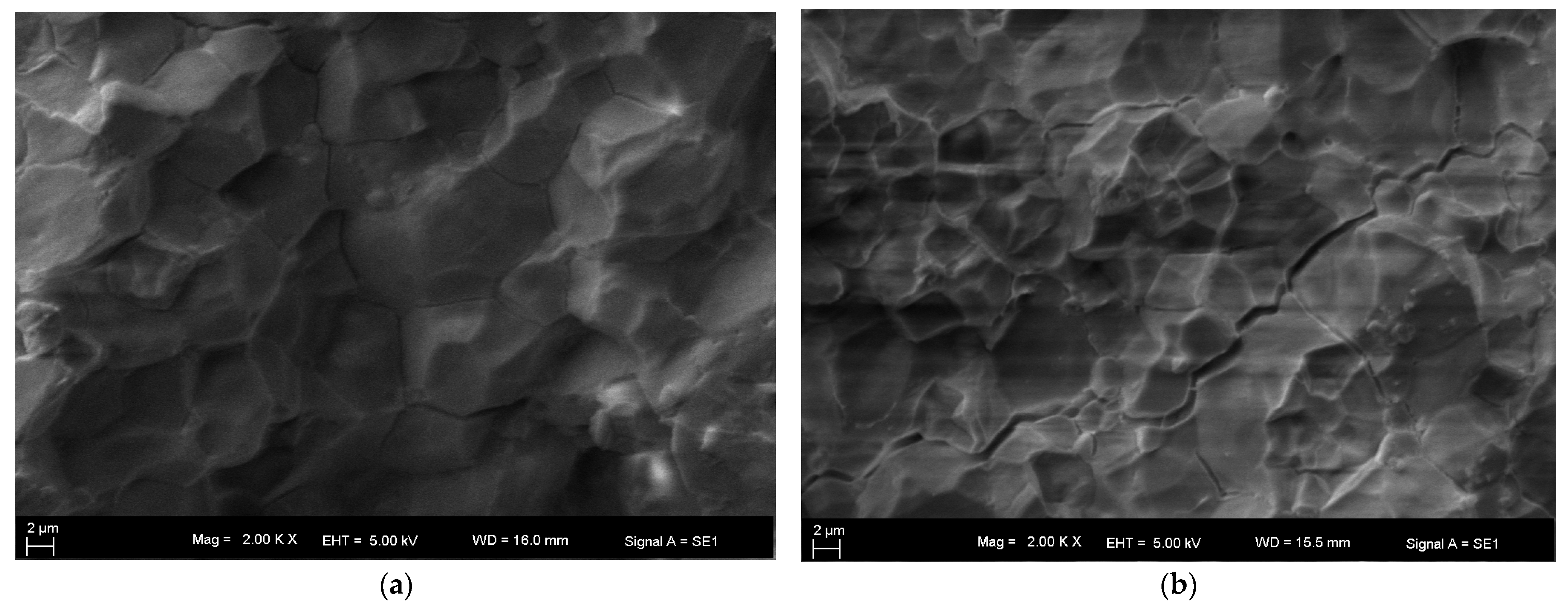
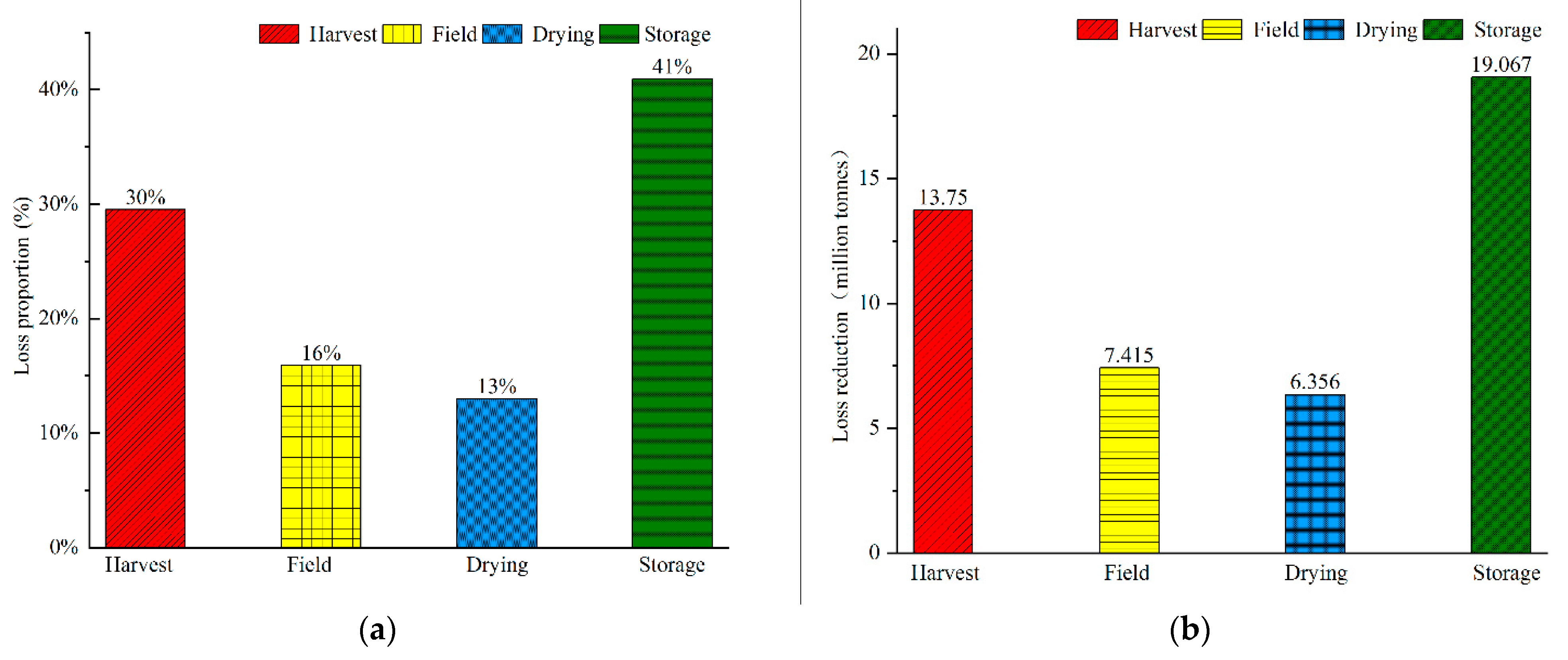
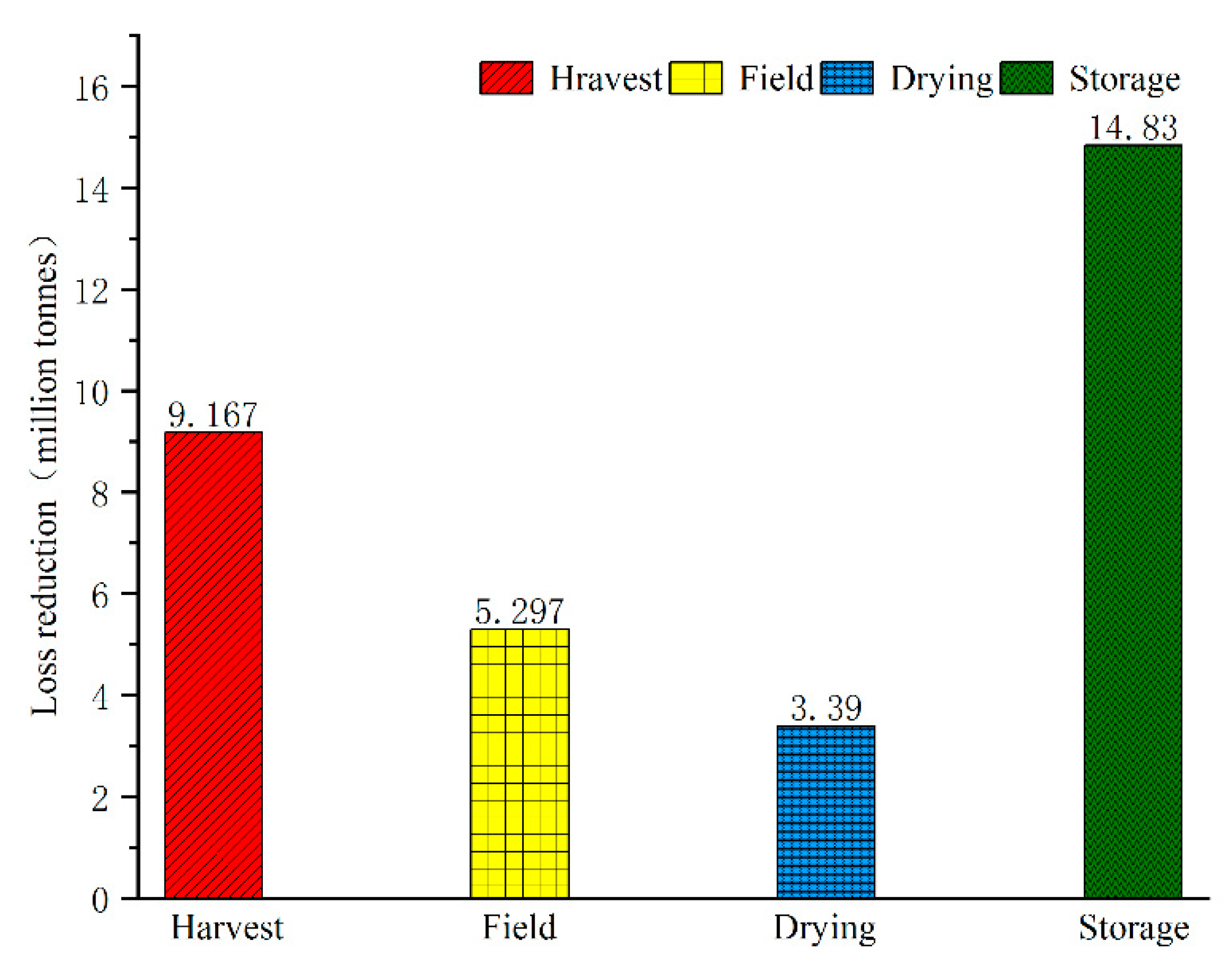
| Period | Necessary Indicators | Necessary Indicator Parameters | Sufficient Indicators | Sufficient Indicator Parameters | ||||
|---|---|---|---|---|---|---|---|---|
| A Grade | B Grade | C Grade | A Grade | B Grade | C Grade | |||
| T1 | Harvesting time deviance (variation coefficient) | ±2 d (4.4%) | ±3.5 d (7.8%) | ±5 d (11.1%) | Loss | ≤2.0% | ≤2.3% | ≤2.7% |
| Harvesting moisture | 24% | 24% | — | Harvesting time | — | — | — | |
| T2 | Mechanical harvesting time | ≤6 h | ≤8 h | ≤12 h | Storage temperature | ≤20 °C | ≤25 °C | — |
| Semi-mechanical harvesting time | ≤12 h | ≤16 h | ≤24 h | Loss | ≤0.1% | ≤0.15% | ≤0.2% | |
| Mould | ≤0.5% | ≤1.0% | ≤1.5% | |||||
| T3 | Accumulated drying temperature | ≥300 (°C·h)/% | ≥280 (°C·h)/% | ≥270 (°C·h)/% | Final moisture | 15% | 14.5% | 14.5% |
| Drying precipitation rate | 0.5%/h | 0.7%/h | 0.8%/h | Rice temperature | ≤30 °C | ≤35 °C | ≤40 °C | |
| Loss | ≤0.1% | ≤0.15% | ≤0.2% | |||||
| T4 | Closing time | ≤1 d | ≤1.5 d | ≤2 d | Impurity rate | ≤0.5% | ≤0.8% | ≤1.0% |
| Closing moisture | 15% | 14.5% | 14.5% | Loss | ≤0.06% | ≤0.08% | ≤0.1% | |
| T5 | Average storage temperature | 15 °C | 20 °C | 25 °C | Delivery moisture | ≤15% | ≤14.5% | ≤14.5% |
| Annual storage accumulated temperature | ≤8395 °C·d | ≤10,220 °C·d | ≤12,045 °C·d | Mould | ≤0.5% | ≤1.0% | ≤1.5% | |
| Fatty acid values | ≤15.0 (mg·100 g−1) | ≤20.0 (mg·100 g−1) | ≤25.0 (mg·100 g−1) | |||||
| Variety | Regression Equation | R2 Value |
|---|---|---|
| JJ816 | Y = −0.0292x + 21.512 | 0.7291 |
| WYD4 | Y = −0.0569x + 27.729 | 0.8127 |
| JJ528 | Y = −0.0302x + 22.759 | 0.7775 |
| JJ528 | JJ816 | WYD4 | ||||
|---|---|---|---|---|---|---|
| Days After Heading (Day) | Dry Matter Weight (g) | Loss Rate (%) | Dry Matter Weight (g) | Loss Rate (%) | Dry Matter Weight (g) | Loss Rate (%) |
| 55 | 19.91 | 0.00 | 24.60 | 0.00 | 21.10 | 0.00 |
| 60 | 19.76 | 0.73 | 24.32 | 1.16 | 20.95 | 0.72 |
| 65 | 19.61 | 1.47 | 24.03 | 2.31 | 20.80 | 1.43 |
| 70 | 19.47 | 2.20 | 23.75 | 3.47 | 20.65 | 2.15 |
| 75 | 19.32 | 2.93 | 23.46 | 4.63 | 20.49 | 2.86 |
| 80 | 19.18 | 3.67 | 23.18 | 5.78 | 20.34 | 3.58 |
| Location | Taonan | Taobei | Jiutai | Jilin |
|---|---|---|---|---|
| Latitude and longitude | East longitude 122°47′ North latitude 45°20′ | East longitude 122°51′ North latitude 45°37′ | East longitude 125°50′ North latitude 44°9′ | East longitude 126°23′ North latitude 43°59′ |
| Variety | Suijing18 (referred to as SJ18) | Hongke181 (referred to as HK181) | Jihong6 (referred to as JH6) | Wuyoudao4 (referred to as WYD4) |
| Harvest date | 25 September 2020 | 5 October 2020 | 17 October 2020 | 3 October 2020 |
| Heading date | 20 July 2020 | 25 July 2020 | 28 July 2020 | 2 August 2020 |
| Days after heading (day) | 60 | 70 | 79 | 61 |
| Yield (kg·hm−2) | 9000 | 10,000 | 8000 | 4670 |
| Location | Taonan | Taobei | Jiutai | Jilin |
|---|---|---|---|---|
| Variety | SJ18 | HK181 | JH6 | WYD4 |
| Days after heading (day) | 60 | 70 | 79 | 61 |
| Sample area(m2) | 3 | 3 | 3 | 3 |
| Shattered grain weight(g) | 35.2 | 49.0 | 151.3 | 61.0 |
| Average weight (g/m2) | 11.7 | 16.3 | 50.4 | 20.3 |
| Yield (kg·hm−2) | 9000 | 10,000 | 8000 | 4670 |
| Loss rate (%) | 0.87% | 1.09% | 4.2% | 2.9% |
| Average loss rate (%) | 3.02% | |||
| Sampling Date | 6:00 | 18:00 | ||
|---|---|---|---|---|
| Moisture Content (%) | Cracking Rate (%) | Moisture Content (%) | Cracking Rate (%) | |
| 28.9 | 26.63 | 0 | 20.41 | 1.33 |
| 29.9 | 20.41 | 1.33 | 14.77 | 0.67 |
| 30.9 | 17.23 | 2.67 | 14.47 | 2.00 |
| 1.10 | 14.28 | 2.67 | 12.04 | 4.00 |
| 2.10 | 12.47 | 2.67 | 10.76 | 3.33 |
| 3.10 | 11.49 | 3.33 | 11.45 | 4.67 |
| 4.10 | — | — | 31.50 | 17.00 |
| Variety | Rice Stored for One Year | Fresh Rice | ||||
|---|---|---|---|---|---|---|
| Appearance | Flavour | Comprehensive Score | Appearance | Flavour | Comprehensive Score | |
| ZhongKeFa5 (Referred to as ZKF5) | 5 | 4.75 | 59.5 | 6.75 | 6.75 | 71.5 |
| JiHong6 (Referred to as JH6) | 6.95 | 6.95 | 75.5 | 7.75 | 7.65 | 83 |
| FangYuan77 (Referred to as FY77) | 5.8 | 5.9 | 66 | 6.9 | 7.05 | 75.5 |
| Periods | Harvest | Field | Drying | Storage | ||
|---|---|---|---|---|---|---|
| Traditional Drying | Over-Drying | Mechanical Drying | ||||
| Loss rate | 6.49% | 3.5% | 3% | 2% | 1.4% | 9% |
Publisher’s Note: MDPI stays neutral with regard to jurisdictional claims in published maps and institutional affiliations. |
© 2021 by the authors. Licensee MDPI, Basel, Switzerland. This article is an open access article distributed under the terms and conditions of the Creative Commons Attribution (CC BY) license (https://creativecommons.org/licenses/by/4.0/).
Share and Cite
Zhang, N.; Wu, W.; Wang, Y.; Li, S. Hazard Analysis of Traditional Post-Harvest Operation Methods and the Loss Reduction Effect Based on Five Time (5T) Management: The Case of Rice in Jilin Province, China. Agriculture 2021, 11, 877. https://doi.org/10.3390/agriculture11090877
Zhang N, Wu W, Wang Y, Li S. Hazard Analysis of Traditional Post-Harvest Operation Methods and the Loss Reduction Effect Based on Five Time (5T) Management: The Case of Rice in Jilin Province, China. Agriculture. 2021; 11(9):877. https://doi.org/10.3390/agriculture11090877
Chicago/Turabian StyleZhang, Na, Wenfu Wu, Yujia Wang, and Shuyao Li. 2021. "Hazard Analysis of Traditional Post-Harvest Operation Methods and the Loss Reduction Effect Based on Five Time (5T) Management: The Case of Rice in Jilin Province, China" Agriculture 11, no. 9: 877. https://doi.org/10.3390/agriculture11090877
APA StyleZhang, N., Wu, W., Wang, Y., & Li, S. (2021). Hazard Analysis of Traditional Post-Harvest Operation Methods and the Loss Reduction Effect Based on Five Time (5T) Management: The Case of Rice in Jilin Province, China. Agriculture, 11(9), 877. https://doi.org/10.3390/agriculture11090877






